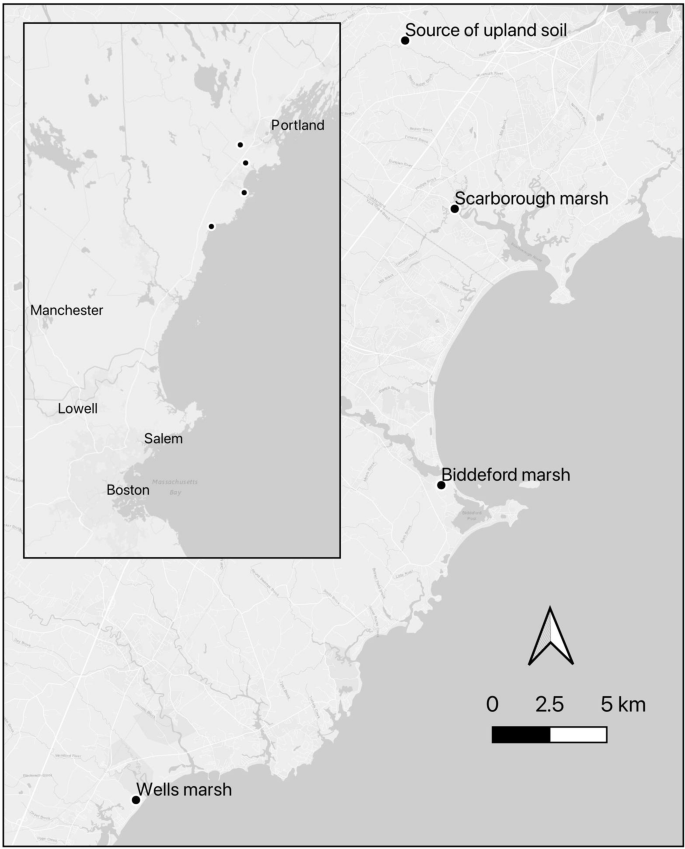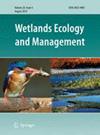Can the marsh migrate? Factors influencing the growth of Spartina patens under upland conditions
IF 1.6
4区 环境科学与生态学
Q4 ENVIRONMENTAL SCIENCES
引用次数: 0
Abstract
Abstract The high elevation salt marsh plant Spartina patens can potentially cope with accelerated sea level rise by migrating inland, but the ability to do so may differ among plant ecotypes. We compared performance among ecotypes collected from three different sites within mesocosms in which we manipulated soil type, plant litter and salinity. Half of our treatment levels simulated conditions plants would encounter when expanding into terrestrial environments (i.e., upland soil, litter present and low salinity); the other half expansion into tidal creeks (i.e., marsh soil, litter absent, and high salinity). Plant litter and salinity did not significantly affect aboveground biomass or rhizome growth and only affected flowering in a three-way interaction with site. However, all three parameters were significantly affected by soil conditions and the site × soil interaction. Upland soil conditions reduced aboveground biomass, rhizome growth and flowering, as compared to marsh soil conditions, for ecotypes from some sites but not others. When just comparing plant performance in the upland soil treatment, ecotypes from some collection sites did better than others. One plausible explanation for this ecotypic variation is pre-adaptation to differences we found in organic matter content among our collection sites, with the ecotype collected from the site with the lowest organic matter content generally being least impacted by upland soil conditions. Our results indicate that S. patens ecotypes can vary in their capacity to successfully expand into uplands, and thus we suggest prioritizing conservation of such ecotypes, as well as their use in restoration efforts. Consideration of ecotypic variation might also prove useful in deciding where to focus conservation efforts for marsh migration.

沼泽能迁移吗?旱地条件下米草属植物生长的影响因素
高海拔盐沼植物米草属(Spartina patens)可能通过向内陆迁移来应对海平面的加速上升,但不同生态型植物的迁移能力可能存在差异。我们比较了从三个不同地点收集的生态类型在中生态系统中的表现,我们控制了土壤类型,植物凋落物和盐度。我们一半的处理水平模拟了植物在扩展到陆地环境(即高地土壤,凋落物和低盐度)时会遇到的条件;另一半扩展到潮汐溪(即沼泽土壤,无凋落物,高盐度)。凋落物和盐度对地上生物量和根茎生长无显著影响,仅与立地呈三向互作关系。但这三个参数均受土壤条件和场地-土壤相互作用的显著影响。与沼泽土壤条件相比,旱地土壤条件减少了某些地点的地上生物量、根茎生长和开花,而其他地点则没有。仅比较旱地土壤处理下的植株表现,某些采集点的生态型表现较好。对这种生态型差异的一种合理解释是,我们发现在不同的采集点之间有机物含量存在差异,从有机质含量最低的地点收集的生态型通常受旱地土壤条件的影响最小。我们的研究结果表明,不同的植物生态类型在向高地扩展的能力上存在差异,因此我们建议优先保护这些生态类型,并在恢复工作中利用它们。考虑生态型的变化也可能有助于决定在何处集中保护沼泽迁移。
本文章由计算机程序翻译,如有差异,请以英文原文为准。
求助全文
约1分钟内获得全文
求助全文
来源期刊

Wetlands Ecology and Management
ENVIRONMENTAL SCIENCES-WATER RESOURCES
CiteScore
3.60
自引率
5.60%
发文量
46
审稿时长
>12 weeks
期刊介绍:
Wetlands Ecology and Management is an international journal that publishes authoritative and original articles on topics relevant to freshwater, brackish and marine coastal wetland ecosystems. The Journal serves as a multi-disciplinary forum covering key issues in wetlands science, management, policy and economics. As such, Wetlands Ecology and Management aims to encourage the exchange of information between environmental managers, pure and applied scientists, and national and international authorities on wetlands policy and ecological economics.
 求助内容:
求助内容: 应助结果提醒方式:
应助结果提醒方式:


